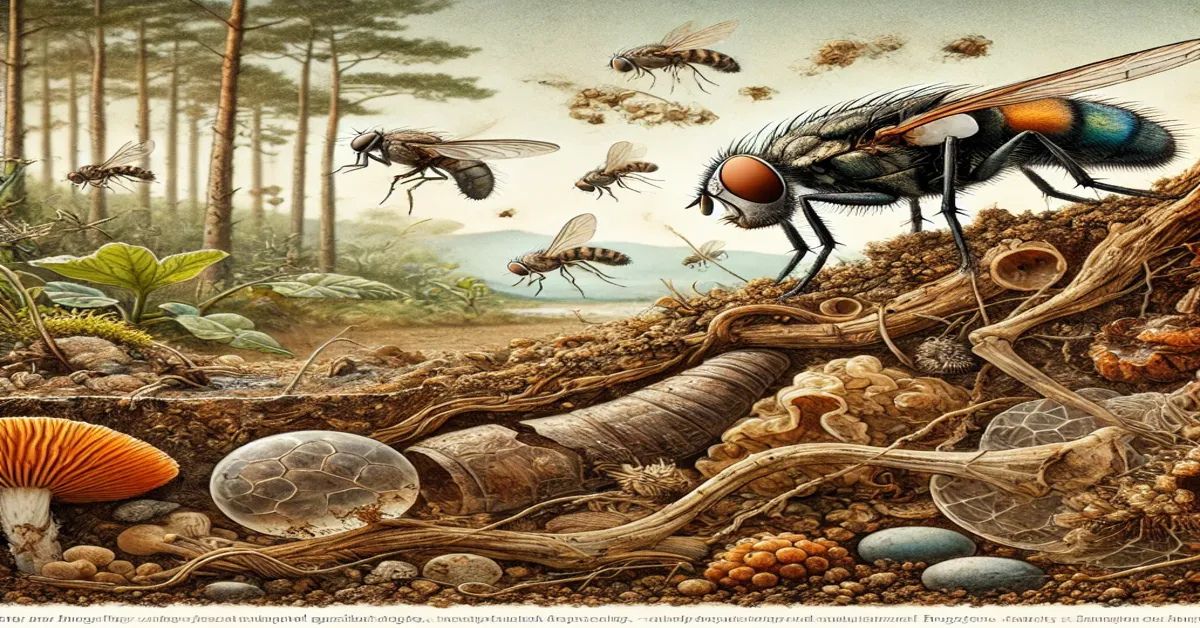The genus Bengalia includes a fascinating group of flies within the family Calliphoridae, commonly known as blowflies. Found predominantly in tropical and subtropical regions of Asia and Africa, Bengalia flies have unique behaviors and ecological roles that set them apart from other members of the blowfly family. Known for their scavenging and predatory behaviors, these flies are often referred to as “crickets’ nightmare” due to their specialized behavior of preying on other insects, particularly ants and termites. Understanding the environmental niche of Bengalia flies offers insight into their adaptation strategies, predatory behaviors, reproductive cycles, and their role in maintaining ecological balance.
This article explores the complex environmental niche of Bengalia, diving into their habitat, unique adaptations, feeding habits, life cycle, predators, and the ecological significance they hold within their ecosystems.
1. Introduction to the Genus Bengalia
The genus Bengalia is a member of the family Calliphoridae, which includes flies that are important for decomposition, pollination, and predation within ecosystems. However, unlike typical blowflies that are primarily associated with decaying organic matter, Bengalia species display a mix of scavenging and predatory behaviors. This genus includes approximately 40 species, with the most notable species being Bengalia depressa, Bengalia peuhi, and Bengalia spinifemorata, among others. These flies exhibit unique feeding strategies and morphological adaptations that enable them to prey on ants, termites, and other insects. Their predatory habits, rare among blowflies, make them crucial players in controlling insect populations in their habitats.
Understanding Bengalia’s environmental niche highlights their ecological importance, as they play a dual role as both predator and scavenger, influencing the populations of other insect species and contributing to nutrient cycling in their ecosystems.
2. Natural Habitat
Bengalia flies are native to tropical and subtropical regions of Asia and Africa, particularly in areas with warm temperatures and abundant insect populations, which provide ample feeding and breeding opportunities.
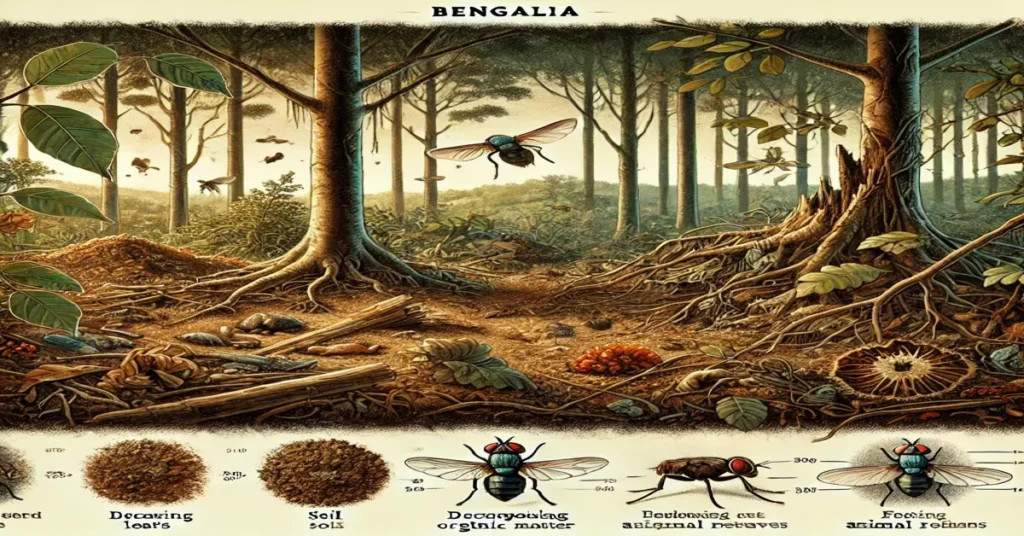
2.1 Geographic Distribution
These species are distributed across Africa, the Middle East, and parts of South and Southeast Asia. They thrive in warm, humid climates, which support high insect biodiversity, particularly in grasslands, forests, and open areas where ant and termite populations are abundant. Countries like India, Thailand, Malaysia, and various parts of sub-Saharan Africa are home to diverse Bengalia species.
2.2 Preferred Ecosystems
The flies favor habitats that are rich in vegetation and have adequate organic material, as these areas support large populations of ants, termites, and other small insects. They are typically found in:
- Tropical Forests: Tropical and subtropical forests provide dense vegetation and high humidity, fostering the diverse insect populations that Bengalia flies prey upon.
- Grasslands and Savannahs: These open habitats are rich in insect biodiversity, particularly ants and termites, making them ideal for Bengalia’s predatory behavior.
- Urban and Rural Areas: Some Bengalia species are also found near human habitations, where they scavenge and prey on other insects in agricultural fields or gardens.
3. Physical and Behavioral Adaptations
The environmental niche of these species is defined by various physical and behavioral adaptations that enable them to thrive as both scavengers and predators.
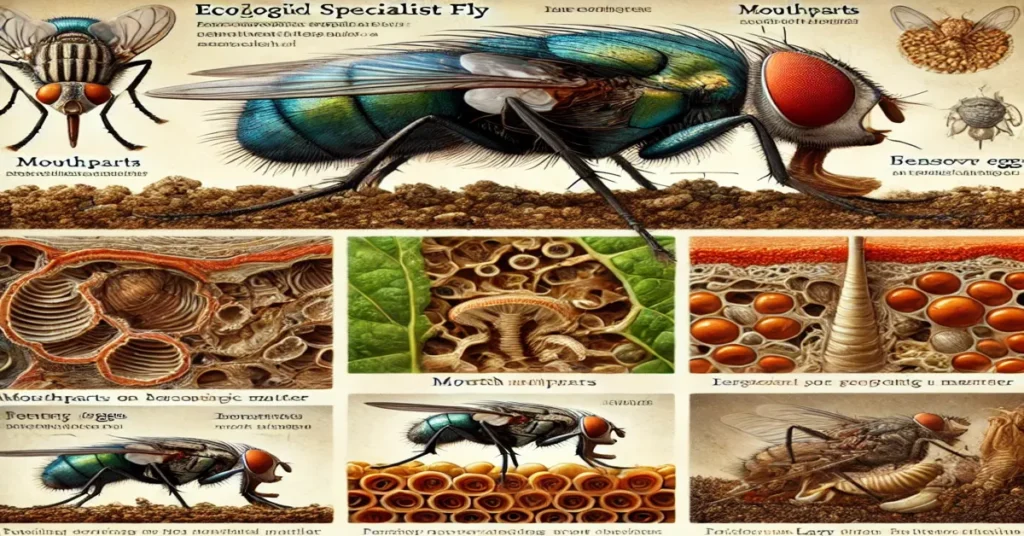
3.1 Physical Adaptations
- Robust Mandibles: One of the most distinctive features of Bengalia species is their powerful mandibles, which are used to seize and manipulate prey. These mandibles are specially adapted for capturing and crushing ants, termites, and other small insects.
- Long Legs and Agile Flight: Bengalia flies possess long legs that give them agility on the ground and allow them to snatch prey with ease. Their strong flight muscles enable rapid, agile movement, which is essential for evading predators and capturing prey in dynamic environments.
- Compound Eyes: Like other flies, Bengalia species have compound eyes that provide a wide field of vision, aiding in the detection of prey and potential threats. Their eyes are highly adapted to detect movement, an essential trait for predatory behavior.
3.2 Behavioral Adaptations
- Predatory Behavior: Unlike most blowflies, these species are highly predatory. They are often seen preying on ants, termites, and even other flies. This predatory behavior allows them to exploit a niche that few other flies occupy, reducing competition for resources.
- Scavenging: While primarily predators, Bengalia flies are also opportunistic scavengers. They feed on decaying organic material, which provides additional nutrients and helps sustain them when prey is scarce.
- Quick Reflexes and Evasive Maneuvers: Bengalia species are known for their quick reflexes, which enable them to dodge attacks from predators or larger insects. This agility is essential for survival in habitats where larger predatory insects and birds are common.
4. Diet and Feeding Habits
These flies have a diverse diet, combining predation on other insects with scavenging behavior. Their unique feeding habits allow them to exploit a variety of food sources within their environment.

4.1 Predatory Feeding
The most unique aspect of Bengalia’s diet is its predatory behavior. They are known to prey on ants, termites, and other small insects. Bengalia flies employ a distinct hunting strategy, hovering near ant trails or termite mounds and snatching individual insects with their mandibles. Their feeding on these social insects helps to regulate their populations, thereby reducing the potential for overpopulation.
4.2 Scavenging and Carrion Feeding
In addition to predation, Bengalia species are opportunistic scavengers, feeding on dead or decaying organic matter. This behavior is common in many blowflies and allows Bengalia flies to exploit additional food resources when live prey is scarce. Their scavenging habits contribute to nutrient cycling in their ecosystem, as they break down organic matter and return nutrients to the soil.
4.3 Opportunistic Foraging
Bengalia flies exhibit opportunistic foraging, taking advantage of whatever food sources are available. This flexibility enables them to survive in diverse environments, where food availability can vary seasonally or due to climatic changes. Their ability to adapt to fluctuating food sources is key to their success as both predators and scavengers.
5. Life Cycle and Reproduction
The life cycle of these species is similar to that of other blowflies, with distinct stages including egg, larva, pupa, and adult. Each stage of their life cycle is adapted to maximize survival and reproductive success within their ecological niche.
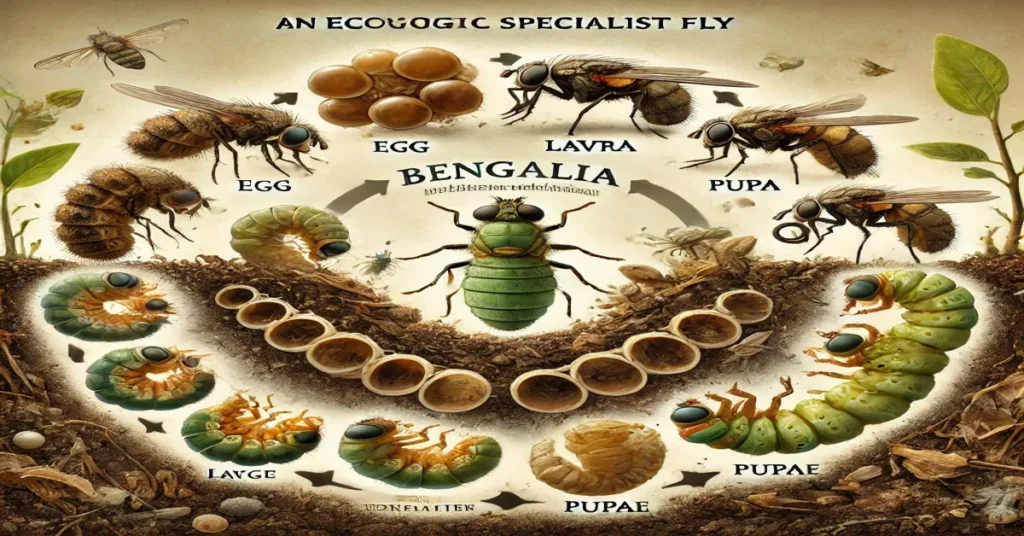
5.1 Egg Laying
Female Bengalia flies typically lay their eggs in decaying organic material or in areas with abundant prey. Each female can lay hundreds of eggs, ensuring that a significant number of offspring will survive despite predation and environmental hazards. The eggs hatch within a day or two, depending on environmental conditions.
5.2 Larval Stage
The larval stage, or maggot stage, is the primary growth phase for Bengalia flies. The larvae are saprophagous, feeding on decaying organic matter or small insects, depending on what food sources are available. This stage lasts several days, during which the larvae consume large amounts of food to store energy for the pupal stage.
5.3 Pupal Stage
Once the larvae reach full size, they enter the pupal stage, where they undergo metamorphosis. The pupal case protects them during this vulnerable phase, allowing them to develop into adult flies. The duration of the pupal stage depends on environmental factors such as temperature and humidity.
5.4 Adult Stage
After emerging as adults, these flies are immediately capable of reproduction. Adults live for several weeks, during which they engage in predatory behavior, feed on various organic matter, and seek out mates. Their relatively short lifespan is balanced by high reproductive output, ensuring population stability.
6. Predators and Threats
Despite their adaptations, these species face several natural predators and threats in their environment.
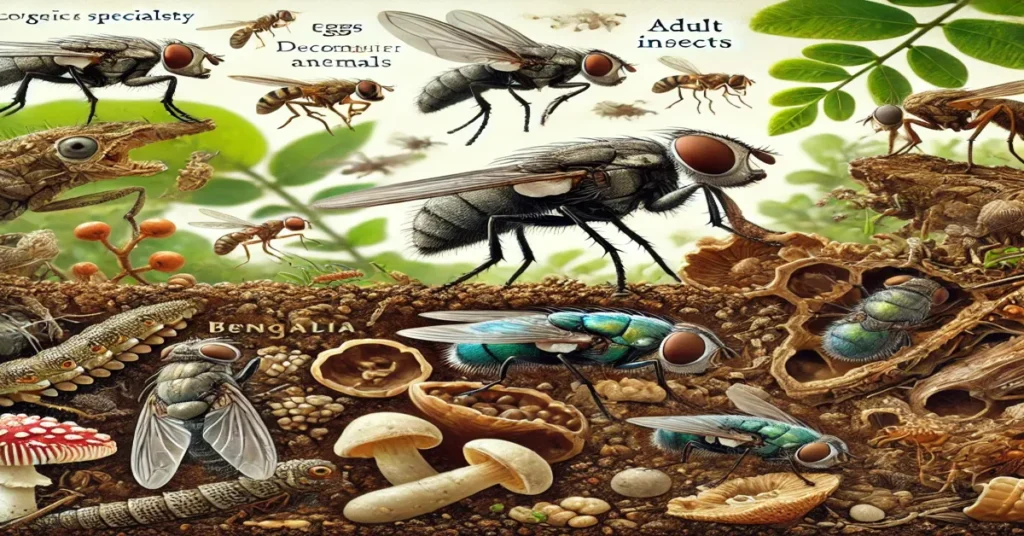
6.1 Natural Predators
- Birds: Birds are among the primary predators of Bengalia flies. Species that specialize in catching insects, such as swallows and flycatchers, pose a significant threat.
- Larger Insects: Predatory insects such as dragonflies and certain types of wasps also hunt Bengalia flies. These predators rely on their speed and agility to catch the flies in flight.
- Spiders: Spiders, particularly those that build webs, can capture Bengalia flies that come too close to their traps.
6.2 Human-Induced Threats
- Habitat Loss: The natural habitats of Bengalia species, particularly in tropical and subtropical regions, are increasingly under threat from deforestation and urban expansion. This habitat loss reduces the availability of prey and suitable breeding sites for these flies.
- Insecticides and Pollution: The use of insecticides in agriculture and residential areas poses a direct threat to Bengalia species, as these chemicals can reduce insect populations indiscriminately. Pollution from industrial waste also degrades the quality of their habitats.
7. Ecological Role and Importance
Bengalia flies play an important role in their ecosystems, contributing to both insect population control and nutrient recycling.
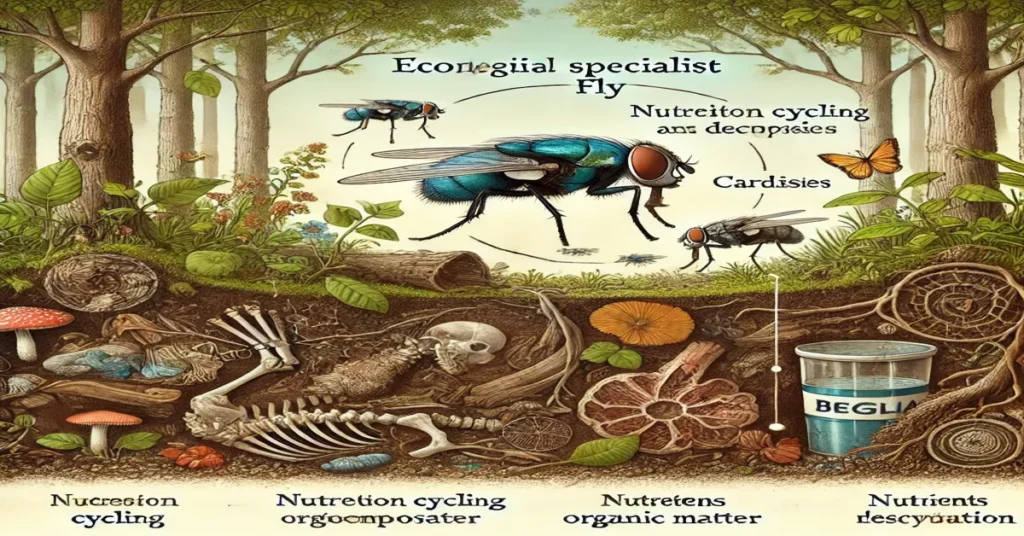
7.1 Population Control of Insects
Through their predatory behavior, Bengalia flies help regulate populations of ants, termites, and other small insects. By preying on these insects, they prevent overpopulation, which can lead to resource competition and imbalances within the ecosystem. This role is particularly important in regions where ant and termite populations are high.
7.2 Nutrient Recycling
As scavengers, Bengalia flies contribute to the decomposition process by feeding on decaying organic matter. Their scavenging activities help break down dead plant and animal material, returning essential nutrients to the soil and promoting the growth of vegetation. This recycling of nutrients is vital for maintaining soil health and ecosystem productivity.
7.3 Indicator of Ecosystem Health
Due to their sensitivity to environmental changes, Bengalia species can serve as indicators of ecosystem health. Changes in their population size or behavior can signal shifts in insect biodiversity, habitat quality, or levels of pollution within an area. Monitoring these flies can provide insights into the state of the ecosystem and help identify potential environmental threats.
8. Conservation and Environmental Significance
Given the ecological roles they play, conserving Bengalia species and their habitats is essential for maintaining biodiversity and ecosystem balance.

8.1 Habitat Conservation
Efforts to preserve tropical and subtropical forests and grasslands, where Bengalia flies thrive, are crucial for the survival of this genus. Conservation organizations work to protect these habitats by promoting sustainable land-use practices, preventing deforestation, and restoring degraded areas.
8.2 Pollution Control
Reducing the use of pesticides and managing waste in agricultural areas can help protect Bengalia flies and other insect species. Implementing eco-friendly farming practices and waste management strategies can create a healthier environment for these flies to survive and fulfill their ecological roles.
8.3 Public Awareness and Research
Raising awareness about the ecological importance of insects like Bengalia can foster greater appreciation and support for conservation efforts. Additionally, further research into the behaviors, adaptations, and environmental needs of Bengalia flies can provide valuable insights into tropical and subtropical ecosystems.
9. Conclusion
Bengalia flies are unique within the blowfly family due to their predatory and scavenging behaviors. Their environmental niche reflects a fascinating blend of adaptations that allow them to function as both predator and decomposer, contributing to insect population control and nutrient cycling within their ecosystems. By understanding the ecological role and environmental needs of Bengalia species, we can better appreciate their significance and the importance of preserving their natural habitats.
Conservation efforts focused on habitat preservation, pollution reduction, and sustainable practices are crucial for supporting Bengalia populations and ensuring the continued health of the ecosystems they inhabit. Through increased awareness and research, we can foster a deeper understanding of these intriguing flies and the roles they play in maintaining ecological balance.
Read More: The Environmental Niche of Hermetia: A Deep Dive into Its Ecological Importance

